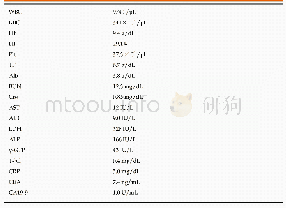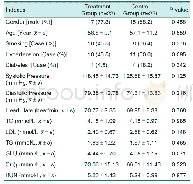《Table 1 The calcium-related laboratory data of two cases》
 提示:宽带有限、当前游客访问压缩模式
提示:宽带有限、当前游客访问压缩模式
本系列图表出处文件名:随高清版一同展现
《Ovarian cancer presenting with hypercalcemia:two cases with similar manifestations but different mechanisms》
Pre-op,pre-operative;post-op,post-operative
A 63-year-old patient was referred to our hospital for lower abdominal distension.She complained of anorexia and constipation for half a year,and her physical examination revealed a pelvic mass with ascites.The dynamic contrastenhanced computed tomography(CT)scan and magnetic resonance(MR)images showed a bilateral ovarian mass(right,10.5 cm;left,4.5 cm;both cystic and solid tumor),with a large amount of ascites.The laboratory findings indicated a high serum calcium level of 15.4 mg/d L(reference range,8.4–10.2 mg/d L).Moreover,the serum cancer antigen 125(CA-125)level was 1080 U/m L,and the human epididymis protein(HE4)level was 180.6 p M.The calcium-related laboratory data were acquired(Table 1)and revealed a suppressed parathyroid hormone(PTH)value and hypophosphatemia.Her serum PTH-related protein(PTHr P)level,as measured using an immunoradiometric assay,was 12.2 pmol/L(normal,<1.3 pmol/L).The singlephoton emission computed tomography(SPECT)bone scan and parathyroid gland scan showed no evidence of skeletal metastasis or parathyroid gland hyperplasia(Figure 1).The patient was treated with vigorous intravenous hydration and diuresis,along with 30 mg of pamidronate by intravenous infusion.Her serum calcium level transiently decreased to10.6 mg/d L,and she underwent a total hysterectomy with a bilateral salpingo-oophorectomy,omentectomy,peritoneal biopsies,and pelvic and para-aortic lymphadenectomy.Intraoperative findings showed bilateral ovarian tumors with mostly solid and partially cystic components,and both the omentum and rectal serosa were involved.
| 图表编号 | XD008422500 严禁用于非法目的 |
|---|---|
| 绘制时间 | 2018.05.01 |
| 作者 | Xuegong Ma、Yingmei Wang、Xuhong Zhang、Mengting Dong、Wen Yang、Fengxia Xue |
| 绘制单位 | Department of Gynecology and Obstetrics,Tianjin Medical University General Hospital、Department of Gynecology and Obstetrics,Tianjin Medical University General Hospital、Department of Gynecology and Obstetrics,Tianjin Medical University General Hospital、Dep |
| 更多格式 | 高清、无水印(增值服务) |





